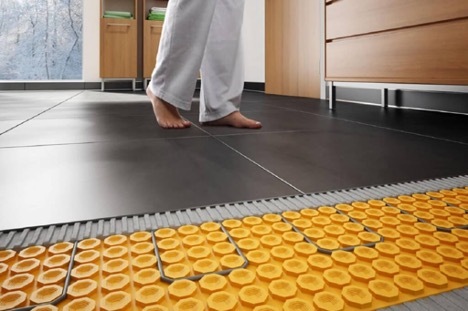The choice of underfloor heating system for porcelain stoneware becomes a key aspect when carrying out renovation work. Considering that porcelain stoneware has increased thermal conductivity characteristics of the tiles ceramic, it is important to choose the best option that will ensure uniform and effective heat distribution.

The content of the article
- Electric or water: which heated floor under porcelain tiles is better
- Features of laying porcelain stoneware on a warm water floor
- Efficiency of underfloor heating under porcelain tiles, which one is better to choose?
- Self-installation: laying porcelain tiles on a heated floor with your own hands
- Conclusion: is a heated floor under porcelain stoneware necessary?
Electric or water: which heated floor under porcelain tiles is better
The question of which heated floor for porcelain stoneware is best to choose requires the analysis of several parameters. On the one hand, electric heated floors under porcelain stoneware are systems that are easier to install and regulate. On the other hand, water systems are more economical in the long term, but require more complex installation.
Porcelain tiles have high thermal conductivity, which makes it an ideal coating for underfloor heating systems. However, this also means that the material will release heat quickly, which can make electrical systems preferable due to their ability to heat up quickly.
Features of laying porcelain stoneware on a warm water floor
When arranging a warm water floor under porcelain stoneware, it is important to consider that this type of coating ideal for heating systems due to its ability to transfer quickly and evenly heat. However, laying porcelain stoneware on a warm water floor has its own nuances, which must be strictly to ensure the durability and efficiency of both the coating itself and the heating system in in general.
Before you begin installation, it is necessary to thoroughly prepare the base. It should be as smooth and strong as possible to eliminate the possibility of deformation of the porcelain stoneware. Any irregularities can lead to the creation of stress in the tile and, as a result, to its damage.
The key is to ensure good waterproofing. A water-heated floor requires the presence of moisture, which should not penetrate into the base. In addition, it is worth taking care of thermal insulation to minimize downward heat loss and increase the efficiency of the heating system.
When installing circuits, you should take into account porcelain stoneware for heated floors - its thickness and thermal conductivity coefficient. Calculation of the pipe laying pitch and screed thickness must be made taking into account these characteristics in order to ensure optimal heating and avoid overheating of the tiles.
It is equally important to choose high-quality adhesives and grouts that can withstand temperature changes and do not lose their properties when heated. They must have sufficient elasticity to prevent cracks and ensure reliable adhesion of the tiles to the base.
After the screed has hardened and the heating system has been checked, you can begin directly laying porcelain tiles on a warm water floor. The process requires care and precision, especially in terms of aligning the tiles and ensuring consistent seams. This is important both for the aesthetics of the appearance of the floor and for the functionality of the entire system.
After laying the tiles and grouting, you must wait a certain period of time for the adhesive and grout to dry completely. Only after this can commissioning of the underfloor heating system be carried out, gradually increasing the water temperature to avoid temperature shock of the material.
Laying porcelain tiles on a warm water floor with your own hands requires a careful approach and knowledge in the field of construction and heating engineering. It is important to remember that each stage of work has its own characteristics, ignoring which it is impossible to obtain a high-quality and durable result. You should always rely on material manufacturers' recommendations and installation instructions.
Efficiency of underfloor heating under porcelain tiles, which one is better to choose?
When considering how to choose underfloor heating for porcelain tiles, there are several key parameters to consider. The effectiveness of the system depends on many factors, including the thermal conductivity coefficient of porcelain stoneware. It is necessary to choose a system that will best match the thermal characteristics of the coating.
Self-installation: laying porcelain tiles on a heated floor with your own hands

Laying porcelain tiles on a heated floor with your own hands is a completely doable task for those who have experience in carrying out such work. To achieve the best result, it is necessary to follow the technology and take into account the specifics of the materials.
Before starting work, you must ensure:
- Preparing the base: it must be smooth and clean.
- Choosing a suitable heating system: you should make sure that the chosen option matches the parameters of the room and the features of the porcelain stoneware.
- Compliance with installation technology: this will ensure the durability and effectiveness of the coating.
Conclusion: is a heated floor under porcelain stoneware necessary?
The final question about whether a heated floor is needed for porcelain tiles often arises at the renovation planning stage. Considering the high thermal conductivity coefficient of porcelain stoneware, the “warm floor” system can significantly increase the comfort of using the room. At the same time, it is necessary to take into account the performance characteristics and compatibility of materials in order to choose the truly best heated floor for porcelain stoneware.


